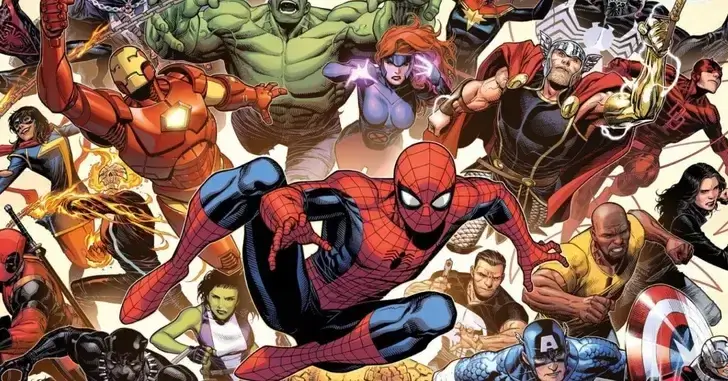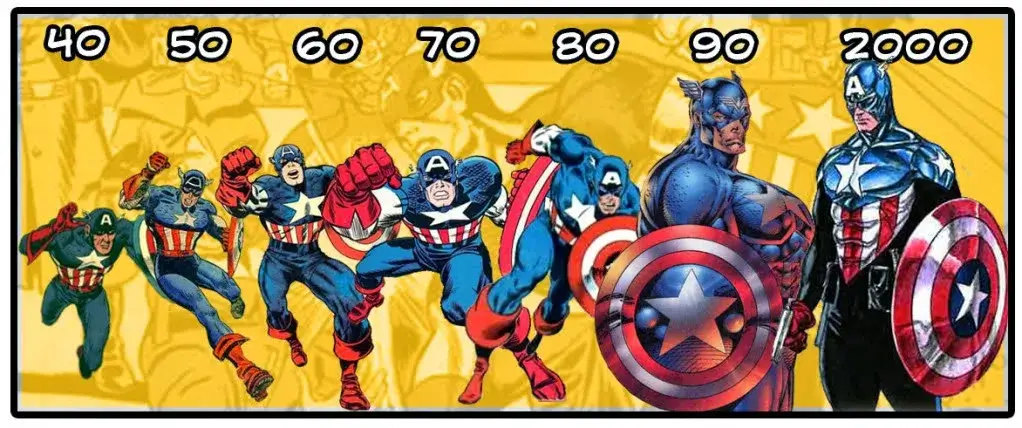1. The Golden Age of Comics (1930s – 1950s)
The Golden Age of Comics is often considered the birth of the superhero genre and the foundation of modern comic books.
This era, spanning the late 1930s to the 1950s, marked the debut of iconic characters who would go on to define the medium for generations.
Rise of Superheroes
In 1938, a monumental event took place in the world of comics: Superman, created by Jerry Siegel and Joe Shuster, debuted in Action Comics #1.
This was the first-ever superhero, a character with superhuman abilities who fought for justice and truth.
Superman’s success was immediately felt, paving the way for a host of other superheroes, including Batman (1939), Wonder Woman (1941), and Captain America (1941).
These characters quickly became cultural icons, symbolizing American ideals during World War II.
Cultural Impact
Comics became a powerful medium for communicating wartime messages, with many stories focusing on the fight against Nazis and fascism.
For instance, Captain America’s first issue featured him punching Hitler in the face—an iconic image that cemented the character’s place in history.
Beyond wartime, comic books offered an escape for readers and became a form of entertainment for children and adults alike.
Influential Creators
While Siegel, Shuster, and Kane are some of the most well-known creators, many others contributed significantly to the rise of the Golden Age.
Artists like Jack Kirby and Joe Simon (who co-created Captain America) helped solidify the superhero genre’s presence in comics.
Their groundbreaking work would inspire generations of writers and artists to come.
Key Comics and Milestones
Action Comics #1 introduced Superman to the world, and Detective Comics #27 marked the first appearance of Batman.
These early comic books laid the groundwork for the superhero genre, and their impact is still felt today in modern comics, films, and TV shows.
2. The Silver Age of Comics (1950s – 1970s)

The Silver Age of Comics is a time of rebirth for the comic book industry, especially after the decline caused by the introduction of the Comics Code Authority (CCA) in 1954.
This era saw a new wave of superheroes and the revitalization of old ones, with a focus on character depth and a shift in storytelling.
Resurgence of Superheroes
With the rise of the Silver Age in the 1950s and 1960s, superheroes made a dramatic return.
In 1956, Showcase #4 introduced the new Flash, revamping the character with a modernized origin and costume.
This heralded the start of a new era for superheroes.
Soon after, Marvel Comics, led by Stan Lee, introduced characters like Spider-Man (1962), the X-Men (1963), and the Fantastic Four (1961), revolutionizing the way superhero stories were told.
Marvel’s approach focused on flawed, relatable characters, and their success would go on to dominate the comic book industry.
Key Influences
The Silver Age coincided with the rise of the counterculture movement in the 1960s, which brought a new wave of social consciousness into comics.
Marvel’s characters began grappling with real-world issues such as prejudice, addiction, and alienation.
The X-Men, for example, were seen as a metaphor for civil rights struggles, reflecting the changing social landscape of America.
The Comics Code Authority
The creation of the Comics Code Authority in the 1950s, in response to growing concerns about the content of comics, had a significant impact.
It limited the scope of what could be depicted in comics, especially concerning violence and adult themes.
This censorship created challenges for creators but also forced the industry to evolve, paving the way for more mature and socially aware stories in the coming decades.
Major Characters and Milestones
The Silver Age gave rise to characters like Spider-Man, who quickly became Marvel’s most popular superhero.
His debut in Amazing Fantasy #15 is considered one of the most iconic moments in comic history.
This era also witnessed the formation of the Avengers and the Justice League, two major superhero teams that would continue to shape comics for years to come.
Read also: Top 10 best graphic novels of all time: Unmissable reads.
3. The Bronze Age of Comics (1970s – 1980s)

The Bronze Age marked a period of transition in comics, as creators began to tackle more serious, real-world issues, and the tone of the stories grew darker and more mature.
Real-World Themes
Comics began to reflect the social upheaval of the 1960s and 1970s, addressing issues like racism, drug addiction, and environmentalism.
The Green Lantern/Green Arrow series in 1970 is a prime example, dealing with issues such as drug abuse and racial inequality.
This shift allowed comic books to be more than just escapism—they became a means of social commentary.
The Shift in Tone
Superheroes were no longer portrayed as perfect, idealized figures.
Characters became more complex and human, with flaws, vulnerabilities, and internal struggles.
This transformation was evident in titles like The Dark Knight Returns (1986), written by Frank Miller, which offered a grittier, more mature take on Batman.
Iconic Series and Creators
Creators like Frank Miller, Alan Moore (known for Watchmen), and Neil Gaiman (creator of The Sandman) emerged during the Bronze Age, pushing the boundaries of what comics could be.
Their work laid the foundation for the rise of the graphic novel and the more sophisticated storytelling that would follow.
4. The Modern Age of Comics (1990s – Present)

The Modern Age of Comics brought a new wave of characters, edgier storylines, and the expansion of comic book universes across films, TV shows, and digital media.
It is also marked by a diversification of characters and the use of new technology to enhance storytelling.
Rise of Antiheroes and Edgier Themes
The 1990s saw the rise of antiheroes, such as Deadpool, Spawn, and Venom.
These characters, often morally ambiguous and deeply flawed, became extremely popular.
Their gritty, rebellious nature contrasted with the traditional hero’s journey, resonating with a new generation of comic fans who sought more complex, mature stories.
Influence of Technology
The advent of digital tools revolutionized the way comics were created.
Digital coloring, inking, and even distribution through platforms like ComiXology allowed comics to reach a wider audience and opened up new creative possibilities for artists.
The success of comic book adaptations in Hollywood also helped elevate the status of comics worldwide.
Diversity in Comics
In recent years, there has been a concerted effort to introduce more diverse characters into mainstream comics.
Characters like Miles Morales (Spider-Man), Kamala Khan (Ms. Marvel), and John Stewart (Green Lantern) have given new representation to people of color, women, and the LGBTQ+ community in comics.
Key Milestones
The rise of Image Comics in the 1990s, founded by creators like Todd McFarlane and Jim Lee, marked a significant turning point in the industry, as creators began to assert more control over their own work.
Additionally, major crossovers like Marvel’s Civil War (2006) and DC’s Rebirth (2016) continue to define the direction of modern superhero storytelling.
5. Key Themes and Trends in Comic History

Throughout the history of comics, certain key themes have emerged and helped define the medium.
Character Evolution
Comics have always been about characters, and as they’ve evolved, so too have their stories.
From the idealized heroes of the Golden Age to the morally complex figures of the Modern Age, characters like Batman, Spider-Man, and Superman have transformed to reflect the times and resonate with each generation of fans.
World-Building
One of the most exciting aspects of comics is world-building.
From the Marvel Universe to the DC Universe, comics have created expansive worlds that allow for endless stories.
These interconnected universes have become a hallmark of modern comics, with crossovers, team-ups, and shared narratives forming the backbone of the genre.
Representation and Diversity
As comics have evolved, there has been a greater emphasis on diversity and representation.
Characters of different races, genders, and sexual orientations are now playing leading roles in the stories.
This shift reflects a broader cultural change and has made comics more inclusive and relatable for fans of all backgrounds.
The Impact of Movies and TV
The success of comic book adaptations in film and television has brought comics into the mainstream like never before.
Movies like The Avengers (2012), Black Panther (2018), and Wonder Woman (2017) have introduced new generations to these beloved characters, while simultaneously helping to boost comic book sales and interest.
6. The Legacy and Future of Comics

The history of comics is still being written, and as the medium continues to evolve, there are exciting developments on the horizon.
With advancements in digital comics, a more diverse range of characters, and ever-expanding film and television universes, the future of comics looks brighter than ever.
New stories, characters, and technologies will continue to push the boundaries of what comics can be, ensuring their place in the hearts and minds of fans for generations to come.
Conclusion
From the Golden Age of superheroes to the modern, diverse, and digitally-driven comics of today, the history of comics is a tale of creativity, evolution, and cultural impact.
Comics have transformed from simple entertainment into a multi-faceted art form that continues to shape and reflect the world we live in.
Whether you’re a lifelong fan or a newcomer to the medium, the world of comics offers a wealth of stories, characters, and adventures waiting to be explored.
Follow our social media to receive content as soon as it is released.👇

